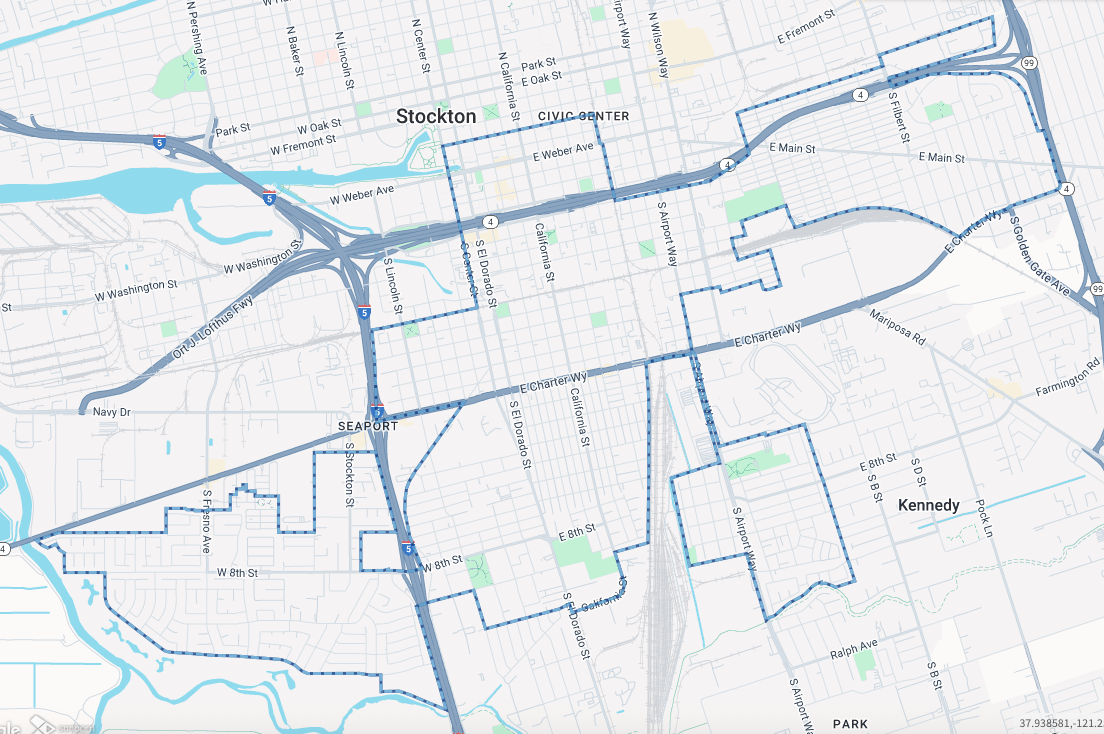ABOUT THE COMMUNITY
Located in the heart of California’s Central Valley and connected to the San Francisco Bay by the San Joaquin River, Stockton is a port city and an agricultural hub. As such, the city has been a node for the siting of heavy industry and major transportation infrastructure.
The city is divided by a network of passenger and freight-carrying railways, two highways (State Routes 4 and 99), and a freeway (Interstate 5). As a result, the city is home to neighborhoods with some of the worst pollution burdens in the state.
Stockton is one of the most demographically diverse cities in California, with a population of approximately 310,000 residents (2020 Census).
The city’s racial and ethnic makeup includes:
- 42% Hispanic
- 24% Asian
- 19% non-Hispanic white
- 13% black
Stockton suffers from higher levels of poverty and unemployment than the rest of the state.
Such inequities are the byproduct of redlining practices and other legacies of structural racism that have dispossessed communities of color from their support networks and concentrated them in neighborhoods with few resources and high health hazards. The city’s 2012 bankruptcy also led to years of disinvestment, which has contributed to Stockton’s slow economic recovery following the Great Recession.
Stockton Rising Project Area
The Stockton Rising project area was configured to bring investment to some of the state’s most disadvantaged neighborhoods. All census tracts within the project area boundary are defined as disadvantaged according to CalEnviroscreen 3.0 (about 75% of the project area ranks within the top 5% of the state).
The project area boundary was also drawn to connect key assets within those census tracts. Key assets include: Stockton’s commercial downtown; the Little Manila historic district; two Amtrak stations that provide direct rail service from Stockton to Sacramento, Oakland, Bakersfield, and San Jose; 11 public parks; six elementary schools; one high school; and one community center.
A Brief History of Stockton: The Legacy of Environmental Injustice
This section provides more history of Stockton, and how environmental injustices from the past still affect the lives of Stockton residents today.
Displacement of Yatchicumne People
The Stockton area was first occupied by the Yatchicumne, a branch of the Northern Valley Yokuts Indians. During the California Gold Rush, gold seekers passed through Stockton on their way to the fields, transforming Stockton from a small settlement to a busy commercial hub. Its strategic location along several waterways led it to become the gateway, supply, and transit center to California’s southern gold mines. During this time, the Indigenous Yokuts were violently displaced.1
1 City of Stockton. 2019. Sustainable Neighborhood Plan.
Emergence as a Hub of Industry and Immigration
After their displacement, Yokut land was commercialized and urbanized. Businesses such as flour mills, wagon factories, and iron works began to grow, especially along the Stockton Channel. A leading industry was the manufacturing of agricultural tools. By the end of the 19th century, Stockton was one of the most industrialized cities in California.2
With industrialization came new immigrant communities. In the 1850s, thousands of Chinese immigrants came to Stockton to escape political and economic unrest in China and in the hopes of discovering gold.3 When the Gold Rush ended, many Chinese immigrants eventually settled in Stockton, having found work on railroads and reclamation projects in the Sacramento-San Joaquin River Delta. In 1880, the city had the third-largest Chinese community in California. However, due to discriminatory laws, like the Chinese Exclusion Act of 1882, Chinese people could not purchase property, and many Americans resented them. It wasn’t until 1962 that American-born Chinese people were allowed to buy property.
In the early 1900s, the shipbuilding industry began to develop, and the Port of Stockton opened as the first inland seaport in California. The modernization of the port brought thousands of African Americans to the shipyards.4 By 1937, ships from across the globe had traveled through Stockton, and the city continued to grow as its industrial base expanded.5
2 https://www.visitstockton.org/about-us/stockton-history/
3 http://downtownstockton.org/stockton_history.php
4 Corburn, Jason and Amanda Fukutome. 2019. Advance Peace Stockton: 2018-2019 Progress Report.
5 https://www.visitstockton.org/about-us/stockton-history
Discriminatory Lending and Investment Practices
As Stockton became increasingly urbanized, it became divided into North and South Stockton by local and federal laws intended to exclude under-resourced communities of color from civic participation, prosperity, and social mobility.6 Specifically, the Federal Housing Administration, created under the New Deal in 1934, designed color-coded maps of neighborhoods in major cities to indicate which were best suited for investment. Through this process, many communities of color, like South Stockton and Downtown, were highlighted as red areas, or areas where banks should not make investments.
As immigrants and residents of color were systematically denied home loans, the value of the areas they lived in fell. For members of these communities, building generational wealth through homeownership was unattainable. On the other hand, white residents in North Stockton were able to own homes and continued to develop further outward. This urban sprawl has led to increased energy use, pollution from automobile reliance, the fragmentation of natural areas, and diminished community cohesiveness.
6 City of Stockton. 2019. Sustainable Neighborhood Plan.
Displacement, Division, and Detention
In the late 1960s, the city government, federal government, and private developers worked together to demolish “blighted” neighborhoods, including Filipino, Chinese, Japanese, Mexican, and African American communities.7 After their displacement, the city built State Route 4, which reinforced the social and economic inequality that already divided North and South Stockton.8 This freeway ran right through Little Manila, one of the biggest Filipino communities in the U.S., devastating families, businesses, and
community centers.
In the 1970s, President Nixon declared the War on Drugs, dramatically increasing criminalization, imprisonment, and punitive sentencing practices, which disproportionately impacted low-income communities of color. The loss of family stability and the rise in violence exacerbated poverty and trauma.
7 Ibid.
8 Ibid.
The Housing Bubble and Municipal Bankruptcy
At the brink of the Great Recession, Stockton had become a hotbed for new developments of upscale housing, approved by city officials hoping to attract the wealthy Bay Area commuters.9 In 2006, the price of homes soared to a median value of nearly $400,000 from $110,000 in 2000.10 Once the housing market began to crash, many referred to Stockton as “ground zero” of the housing crisis.11 In 2007, Stockton had the highest foreclosure rate of the top 100 metro areas, with one foreclosure for every 27 households.12 In 2012, Stockton became the largest city in the U.S. to declare bankruptcy. While devastating, its bankruptcy ushered in a new era of change that Stockton is advancing toward.
9 City of Stockton. 2019. Sustainable Neighborhood Plan.
10 Christie, Jim. 2012. “How Stockton went broke: A 15-year spending binge.” Reuters.
11 Clark, Andrew. 2008. “Mortgage crisis: Welcome to sub-prime capital, USA.” The Guardian.
12 Christie, Les. 2007. “California cities fill top 10 foreclosure list.” CNNMoney.com.
A New Era of Local Planning and Policy
In 2015, the city left bankruptcy protection and started on a path to reinvent itself as a sustainable city, fiscally and environmentally.13 For example, Stockton has developed a long-term financial plan to advise financial decisions and created its own Office of Performance & Data Analytics to promote transparency and accountability. There have also been efforts to address environmental challenges, including the Community Emissions Reduction Program, the Clean Truck Program in the Port of Stockton, and the 2040 General Plan, which contains many goals, policies, and actions that address public health, environmental justice, air quality, and climate change.14
Despite these recent planning efforts, the legacy of racist land use policy remains apparent in Stockton. An unequal distribution of resources has left Stockton’s communities of color to combat extreme heat, air, and water pollution, chronic poverty, and homelessness at greater levels than those in whiter and wealthier neighborhoods. These persistent inequities ultimately drove community-based organizations to apply for TCC funding.
13 City of Stockton. 2015. “News Release – Stockton Exiting Bankruptcy.”
14 City of Stockton. 2018. Envision Stockton 2040 General Plan.
Local leaders win three separate TCC awards to address persistent inequities in
South Stockton.
Top page photo:
The intersection of Miner Avenue and San Joaquin after TCC investments in active transportation upgrades.
Credit: Siegfried Engineering, Inc.


